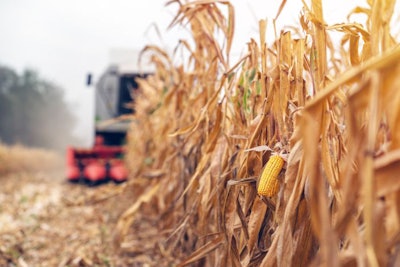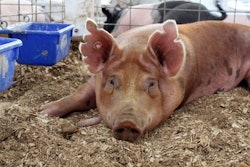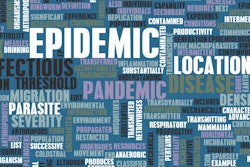
Wet corn harvests in 2018 and 2019 mean producers must closely track the levels of mycotoxins in feed
After the two wettest years on record back to back, Max Hawkins, Ph.D., nutritionist for Alltech’s Mycotoxin Management team, cautions poultry, cattle and swine producers feeding corn to their animals: Test, test, test.
“Everybody needs to test because there’s a broad variation in risk across the country,” he said in a webinar on mycotoxin management on March 31. “If we don’t test, we can’t understand what that risk is, and we have to understand the risk in order to formulate a program.”
2018 and 2019 were the wettest seasons in the U.S. in 127 years of recorded history – prime conditions for mycotoxin growth.
“We’ve had a situation that really sets us up to have lots of mycotoxins, lots of mold production and that’s exactly what we have,” Hawkins said.
In the 260 samples of corn grain and corn silage from across the U.S., the average number of mycotoxins per sample was more than 7, up slightly from a year ago. While the average numbers found in the samples are not particularly concerning, Hawkins said the high-risk levels are. This is why he said testing is so important.
“Those high-risk levels are out there,” he said. “Average-wise, if I had to feed this sample of average level for corn, I’d be fairly pleased for this year. … All in all, I think that we’re in pretty good shape, on the average, but the thing is, that we have to remember that all samples are not average.”
He said testing corn as it is fed to animals can minimize the risk to the animals.
“You need to test your own; you need to know what the risk is in that corn as you purchase it or as you feed it out so that you can formulate a program to best minimize the risk,” he said.
Distribution maps that show the levels of mycotoxins found across an area “are fun to look at, but you need to realize that there’s low risk, high risk all in the same neighborhood, the same region,” Hawkins said. “So, what that really tells you is that everybody needs to test their own corn to know exactly what the risk is. I say that risk can vary from one side of the field to the next, one end to the other, so it can certainly vary down the road.”
High risk for DON, zearalenone
Hawkins said that last year’s corn crop had a high risk for deoxynivalenol (DON) and zearalenone, and he added that the increase of zearalenone since 2015 is notable.
“When you run the numbers over the past two years, DON, in terms of percent occurrence, goes from 58 to 89% occurrence and zearalenone goes from 5% occurrence in 2015 to over 50% occurrence in 2019,” he said. “Keep in mind that (zearalenone) is more prevalent, we see it much more often and we see it at higher levels today than we have in years past.”
In ruminants, the type of animal, age and production status all play a part in the risk of mycotoxins to the animal; in poultry, there is risk to all three phases of production – layers, broilers and starters.
“I really caution people this year, particularly as we’re feeding this corn to developing heifers, young calves, even if we’re feeding developing bulls, zearalenone can be severe negative impact on what we’re doing for reproductive development, overall health status of these cattle,” he said. “The co-occurrence of DON and zearalenone is really a broad-spectrum impact on the cattle. From feed intake, rumen function, gut health, gain, liver function, immune response, and then we’ve got the added impact of reproductive performance or impairment of reproductive performance.”
He said that the mycotoxin risk from multiple sources need to be taken into account as the feed is formulated.
“As we get into reproductive herds, we need to pay more attention to the zearalenone that could be present in these corn grains. We saw the same trend in corn silage,” he said. “So, you’re putting corn grain on top of corn silage, adding more zearalenone, more DON on top of already-present DON and zearalenone. So, we have to be very cognizant of what that risk potential may be.”
While Hawkins said poultry are more tolerant to some of the mycotoxins than swine, risk is still present.
“When we get into monogastrics, zearalenone can be much more impactful — egg production in poultry, reproduction in swine,” he said. “Once you get behind on that reproductive schedule, it going to take much longer because now you have to take multiples of reproductive phases to get back on track. So, instead of taking a few days, it can take a few months.”
Production losses
Hawkins said the production losses that can result from feeding corn contaminated with mycotoxins can really add up for producers. Layers could lose 33 cents in profit per hen, broilers could lose 12 cents per bird, nursery pigs could lose a nearly $3 margin over feed per pig and grow-finish pigs could see a $6.69 carcass profit loss. Added up over a large flock or herd, these losses can add up.
“These numbers can add up to huge dollars very, very quickly,” he said. “If you don’t run the data, you’re not going to know that these numbers exist until the pigs are all sold.”
Monitor storage
Hawkins also said that the wet harvest from last year means corn and corn silage in storage must be closely monitored.
“I’ve always emphasized to monitor storage. I think that, this year, that may be even more important,” he said.
He said that corn grain has tended to be put into bins too wet and fermented feed put up too dry. He added that there was a 27% increase of grain entrapment incidents from 2018 to 2019, due to grain being put into storage too wet. There has also been an increase in bin fires.
“We’ve got storage problems, it’s quite evident,” he said.











